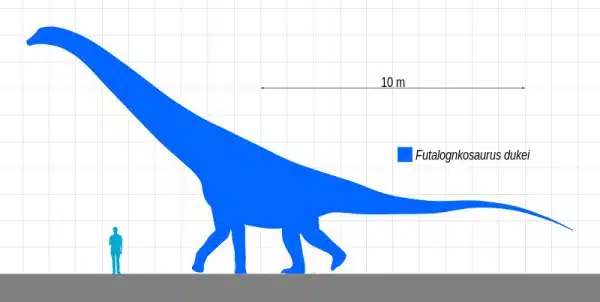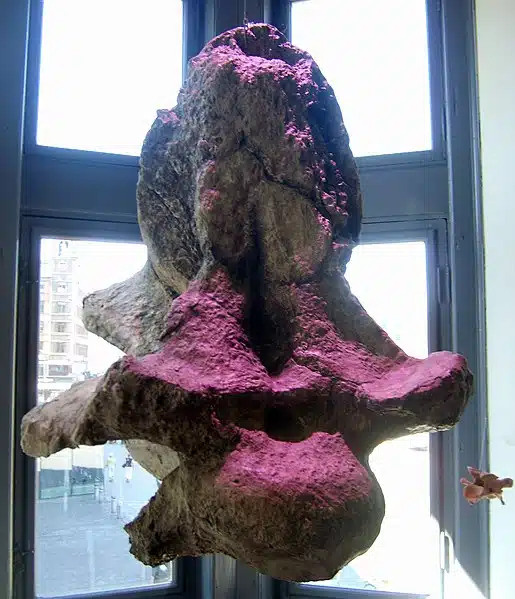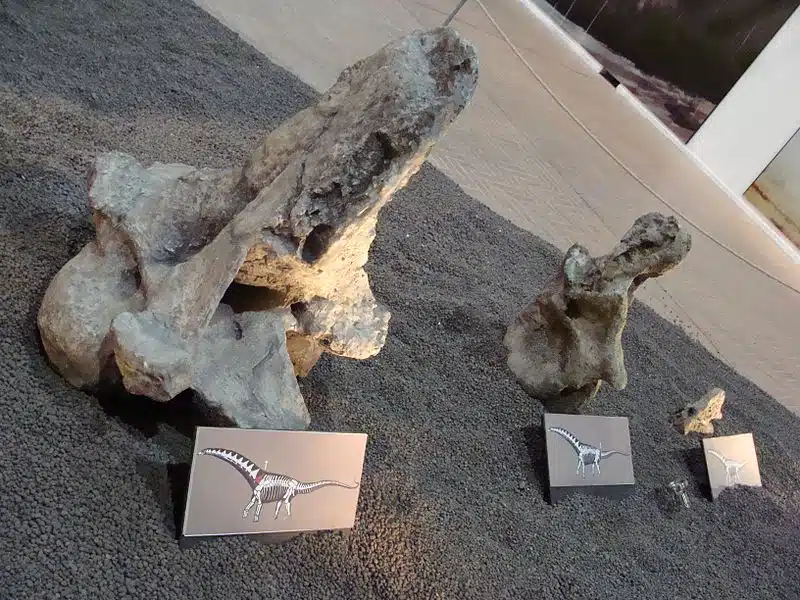Imagine stepping back in time, about 90 million years ago, to the Late Cretaceous Period. You’re in what is now Argentina, and towering above you is one of the most colossal creatures to have ever walked the Earth. Meet Futalognkosaurus, a name that translates to “Giant Chief Lizard.” This gentle giant, a herbivorous sauropod, roamed the ancient landscapes, leaving behind clues that have fascinated paleontologists for decades.
Futalognkosaurus Key Facts
| Keyword | Fact |
|---|---|
| Pronunciation | foo-ta-logn-koh-saw-ruhs |
| Meaning of name | Giant Chief Lizard |
| Group | Sauropoda |
| Type Species | Futalognkosaurus dukei |
| Diet | Herbivore |
| When it Lived | 93.9 to 86.3 MYA |
| Period | Late Cretaceous |
| Epoch | Late/Upper Turonian to the top of the Early/Lower Coniacian |
| Length | 79.0 to 112.0 feet |
| Height | Approximately 13.0 feet at hips |
| Weight | 32.0 to 55.0 tons |
| Mobility | Moved on all four |
| First Discovery | 2000 by team of Argentinean paleontologists |
| Location of first find | Neuquén, Argentina |
| First Described by | 2000 by Jorge Calvo, Juan Porfiri, Bernardo González-Riga and Alexander Kellner |
| Holotype | MUCPv-323 |
Futalognkosaurus Origins, Taxonomy and Timeline
Futalognkosaurus, a name resonating with grandeur, originates from the Mapuche indigenous language. “Futa” means “giant” and “lognko” means “chief,” aptly describing this behemoth. The Greek “sauros,” meaning lizard, completes its name. Its species name, ‘dukei’ refers to Duke Energy Argentina Company, who financially supported fieldwork in 2002-2003.

Belonging to the Sauropoda, specifically the titanosaurid, Futalognkosaurus dukei stands as a testament to the diversity of these long-necked giants. Its classification places it among some of the largest animals to have ever walked the Earth.
This magnificent creature lived during the Late Cretaceous Period, specifically from the Late Turonian to Early Coniacian Ages. Its reign spanned from approximately 93.9 to 86.3 million years ago, a time of significant geological and climatic changes.
Discovery & Fossil Evidence
The discovery of Futalognkosaurus in the Neuquén province of Argentina in 2000 marked a significant milestone in the field of paleontology. It wasn’t until 2007 that this colossal creature was scientifically described, sharing the spotlight with other contemporaries such as Megaraptor, Unenlagia, Iguanodonts, Peirosaurids, and Pterosaurs.
The holotype was found near the margins of a river. It’s hypothesized that after the demise of this giant, its body was washed into the river. Due to its immense size, the carcass likely acted as a natural barrier, altering the river’s course. This obstruction was significant enough to last long enough for fish and bivalves to inhabit it, eventually leading to the formation of an oxbow lake.
- Futalognkosaurus neck vertebra cast, on temporary exhibit in Copenhagen.
- Futalognkosaurus Royal Ontario Museum
- Futalognkosaurus vertebrae on display in Udine, Italy.
- Skull of Futalognkosaurus on Display at the Royal Ontario Museum
Futalognkosaurus Size and Description
Futalognkosaurus dukei, a sauropod of staggering proportions, was characterized by its long neck, which contained 14 vertebrae and was over a meter deep due to its extremely tall neural spines with a distinctive “shark-fin” shape. Its hips were notably large and bulky, reaching a width of nearly 9.8 feet.
Size and Weight of Type Species

The holotype of Futalognkosaurus dukei, known as MUCPv-323, was originally estimated to be between 105.0 to 112.0 feet in length. Over the years, there have been several revisions and estimates regarding its size. These varying figures reflect the complexities and challenges in determining the exact dimensions of such colossal creatures. However, the most up-to-date estimate, provided in 2020 by Molina-Pérez and Larramendi, suggests a length of 79.0 feet and a weight of 33.0 tons. This latest assessment offers a more refined understanding of the sheer magnitude of this giant.
The Dinosaur in Detail
Futalognkosaurus stands out not just for its size but also for its unique features. Its cervical vertebrae, for instance, exhibit distinct characteristics that set it apart from other sauropods. These features not only reflect its adaptability but also provide clues about its lifestyle and behavior.
One notable specimen, the holotype MUCPv-323, has been instrumental in shedding light on this dinosaur’s anatomy. Its well-preserved state allows paleontologists to delve deeper into the nuances of its skeletal structure, offering a window into a bygone era.
Interesting Points about Futalognkosaurus
- Futalognkosaurus is one of the largest dinosaurs ever discovered (Titanosauria), showcasing the incredible size potential of sauropods.
- Its discovery in Argentina adds to the rich fossil record of South America, a hotspot for sauropod finds.
- The name Futalognkosaurus reflects a beautiful blend of indigenous language and Greek, highlighting the global nature of paleontology.
- Despite its colossal size, this gentle giant was a herbivore, feeding on the lush vegetation of the Late Cretaceous.
Futalognkosaurus in its Natural Habitat
Futalognkosaurus thrived in a world vastly different from ours. The Late Cretaceous was a time of diverse ecosystems, with a climate that supported lush vegetation. This herbivore likely roamed vast expanses, feeding on the abundant plant life.
As a quadrupedal giant, Futalognkosaurus would have had a significant impact on its environment. Its feeding habits and sheer size could have shaped the landscape, possibly even influencing the ecosystem around it. While details about its social behavior are speculative, it’s possible that these giants moved in herds, traversing the ancient landscapes in search of food.
Contemporary Dinosaurs
In the lush, verdant world of the Late Cretaceous, the colossal Futalognkosaurus lumbered through the ancient forests, its massive frame casting a shadow over the smaller Anabisetia, which scurried in the underbrush. This gentle giant, dwarfing even the towering trees, lived alongside some of the most awe-inspiring dinosaurs of its time. Imagine a world where the ground trembled under the weight of these behemoths, a world ruled by scales and roars.
Not far from where Futalognkosaurus grazed, Argentinosaurus, another titan of its era, roamed. These two giants, though similar in their gargantuan size, were like ships passing in the night, each a master of its domain. They were the colossal vegetarians of their time, perhaps competing for the lush foliage, yet there was a sense of coexistence, a mutual understanding in their shared enormity. Their size alone was a deterrent, making them less appealing targets for predators, but not entirely out of danger.
Lurking in the shadows, the formidable Giganotosaurus, a predator of terrifying proportions, eyed these giants. While Futalognkosaurus was larger, the cunning and speed of the Giganotosaurus made it a threat not to be taken lightly. It’s not hard to imagine a tense encounter between these titans, a dance of predator and prey where size met speed in a battle for survival. Futalognkosaurus, despite its size, would have had to be wary of this formidable hunter.
In this mesozoic drama, the smaller herbivorous Cathartesaura played a different role. Perhaps it ate what the giants left behind or darted between their massive legs, living in a world of giants. Futalognkosaurus, in its grandeur, was the central figure in this ancient story, a testament to the diversity and complexity of life millions of years ago. Each dinosaur, from the towering Argentinosaurus to the swift Giganotosaurus, played a part in shaping the life and environment of Futalognkosaurus, painting a vivid picture of an ecosystem where size, strength, and cunning dictated the rules of existence.
Frequently Asked Questions
It means “Giant Chief Lizard,” derived from the Mapuche and Greek languages.
It lived during the Late Cretaceous, around 93.9 to 86.3 million years ago.
It was discovered in Neuquén, Patagonia, Argentina.
It’s a sauropod, specifically a titanosaurid.
It was a herbivore, feeding on plants.
It was discovered in 2000 by Argentinean paleontologists led by Jorge Calvo.
Sources
The information in this article is based on various sources, drawing on scientific research, fossil evidence, and expert analysis. The aim is to provide a comprehensive and accurate overview of Futalognkosaurus. However, please be aware that our understanding of dinosaurs and their world is constantly evolving as new discoveries are made.
- https://www.researchgate.net/publication/6071132_A_new_Cretaceous_terrestrial_ecosystem_from_Gondwana_with_the_description_of_a_new_sauropod_dinosaur
- https://www.researchgate.net/publication/275889369_Re-sizing_giants_estimation_of_body_lenght_of_Futalognkosaurus_dukei_and_implications_for_giant_titanosaurian_sauropods
- https://www.geol.umd.edu/~tholtz/dinoappendix/appendix.html
This article was last fact-checked: Joey Arboleda, 11-04-2023
Featured Image Credit: Nobu Tamura, CC BY 3.0, via Wikimedia Commons




